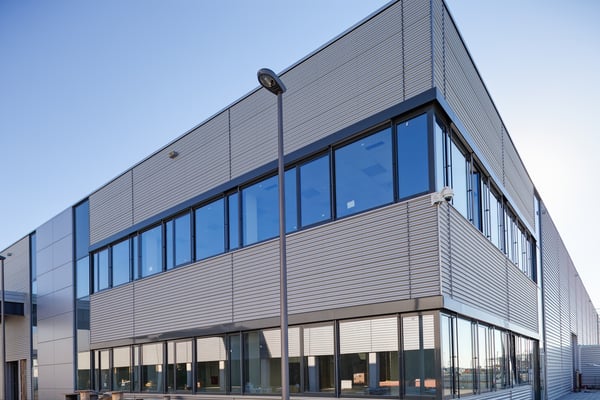Wall Systems: Exterior Wall Types

We previously published an article covering the basic concepts of exterior wall systems, including key terms and definitions. On this occasion, we will discuss the three main types of exterior walls for commercial building enclosures: cavity wall, barrier wall, and mass wall. Each type has advantages and limitations, like in any engineering decision.
Save on space heating and air conditioning with an energy efficient building envelope.
Cavity Wall
A cavity wall is also known as a screen or drained wall system. This wall type is the most common in most climatic and rainfall zones, for two main reasons: the pressure equalization that can be obtained, and the ability to endure bulk rainwater penetration.
A cavity wall is any wall system or assembly that uses a concealed air space and drainage plane to resist bulk rainwater penetration. Depending on its design, a cavity wall may also improve the thermal performance of the building. Cavity walls generally include the following characteristics:
- An exterior cladding element that is designed to shed or absorb most of the bulk rainwater, before it enters the concealed spaces if the assembly.
- A drainage cavity, created to collect and manage rainwater that is not absorbed by the exterior cladding element. This cavity or airspace may be ventilated for pressure equalization, either mechanically or passively. By avoiding a negative air pressure, the ventilation system keeps rainwater away from dry sections of the wall.
- An internal drainage plane, which serves as the primary line of defense against uncontrolled rainwater penetration. This drainage also serves as a division between the wet and dry zones of the exterior wall assembly.
- An insulating layer, which can be located either inboard or outboard of the internal drainage plane.

Cavity walls offer many advantages and are preferred by many builders, compared with other types of exterior wall systems. However, proper design of the wall system is key to achieve the expected performance. An inadequate design and installation can result in costly repairs and disruptions after construction. The following are some important issues to consider:
- Corrosion of mild steel elements and interior mold growth often remain concealed in this type of wall system. This can happen over many years, before manifesting outside the wall assembly.
- The primary drainage plane and the most critical interfaces are often located in the wet zone of the wall system. This makes any repair or intervention highly invasive and disruptive, especially in an occupied building.
An adequate quality assurance program for the building envelope can reduce the risk of improper design, and ensure an effective installation during initial construction.
Barrier Wall
A barrier wall is any exterior wall system that depends on a weathertight outermost surface and construction joints to resist bulk rainwater penetration and moisture ingress. This type of wall is usually associated with precast concrete panels, composite and solid metal plate exterior cladding, and exterior insulation finishing systems (EIFS). This type of exterior wall is the most cost-effective, but it has some limitations that must be considered:
- Provides a single line of defense against bulk rainwater penetration.
- Requires a high level of workmanship, due to the complex interface details it includes.
- Requires specialized maintenance to remain effective during its life cycle, which results in higher maintenance costs over time.
Barrier walls have zero margin of error during their design and installation: if there are any defects, rainwater can reach the dry zone of the wall directly. In extreme cases, rainwater may reach indoor spaces and cause major damage.

Mass Wall
Mass walls can be considered the opposite of cavity walls: they rely on a combination of wall thickness, storage capacity, and bonding between masonry units to resist bulk rainwater. Building designers must understand the behavior of mass walls in terms of storage capacity, heat transfer and moisture transfer. Evaporative drying must be avoided in mass walls, since it can have negative effects like efflorescence, deterioration of plaster finishes, and mold growth. The following are some important design considerations for mass walls:
- Rain protection
- Wetting rate
- Storage capacity
- Drying rate
Exceeding the manageable storage capacity for an extended time may create long-term moisture problems, affecting the substrates in contact with the mass wall. Mass walls are retrofitted into cavity walls in some cases, especially when interior finishes are being affected by moisture infiltration.

Anuj Srivastava
Anuj Srivastava is a principal partner at NY Engineers. He is known for his MEP franchise market knowledge. Anuj is currently leading a team of 100+ MEP/FP engineers and has successfully led over 1500 franchise projects in the US.
Join 15,000+ Fellow Architects and Contractors
Get expert engineering tips straight to your inbox. Subscribe to the NY Engineers Blog below.



